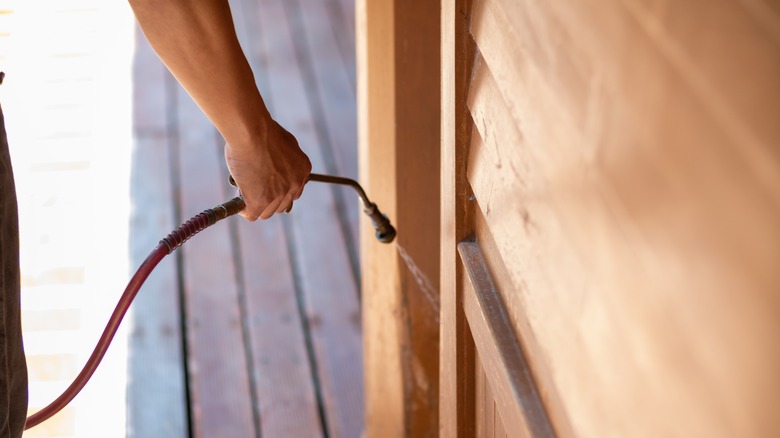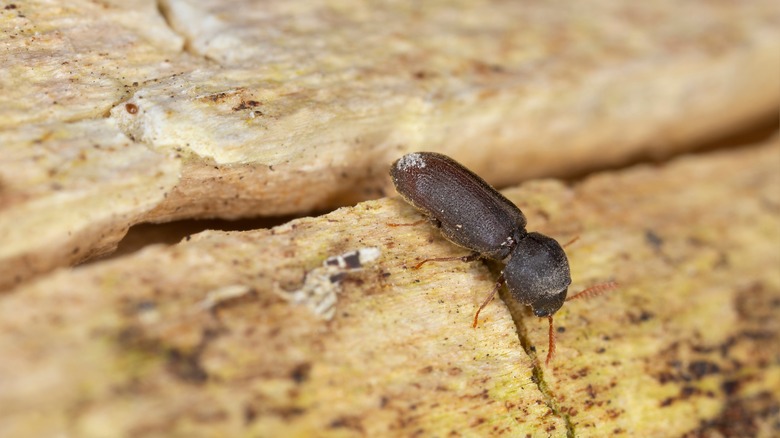The Pesky Beetle That Calls For Something Stronger Than Vinegar
Vinegar is one of the most versatile household products out there. In addition to using vinegar to cook and clean, you can also use it to get rid of pests like fruit flies, ants, and snails. But for some bugs, vinegar just doesn't cut it. That includes powderpost beetles, which can damage wood similarly to termites and call for something much stronger than vinegar, such as a fumigation or temperature treatment.
Powderpost beetles are named after the fine powder that they leave behind while tunneling through wood. Several different beetles may be referred to by this name, and it's not the actual beetles that do damage — it's their young. The eggs hatch inside of your furniture in the form of larvae known as woodworms, which chew through the interior of the wood before tunneling out as adult beetles. Small holes and piles of wood dust are the main signs of a powderpost beetle infestation. Some species only attack hardwood, while others will damage softwood as well. In addition to furniture, this can include floors, cabinets, door frames, windows, and structural components of a building.
Vinegar isn't able to enter the shells of powderpost beetles, so it doesn't harm them enough to kill them. It also can't penetrate deep enough to remove larvae in wood, and it can damage the wood over time as well. Instead, once you're sure of an infestation, you'll need to use more foolproof methods and potentially enlist a professional to get rid of these pests.
How to get rid of powderpost beetles
Because their larvae live inside wood, powderpost beetles are tricky to get rid of yourself. Your first option is to use a pesticide. Borate spray is one popular option for powderpost beetles that not only hits the top of the wood but also penetrates the interior, killing the larvae as well as adult beetles. Just keep in mind that it won't work on finished or painted wood. Sprays that contain permethrin, cypermethrin, or cyfluthrin are also effective at killing adult beetles but won't penetrate the wood fully enough to reach the larvae. Try applying the spray in springtime, when the insects are leaving the wood. You may also need to apply multiple times.
Alternatively, you can do a temperature treatment on wood items by placing them in an oven, heat chamber, or deep freezer long enough to kill the beetles and larvae. Aim for four hours at 150 degrees Fahrenheit, or three to seven days at 0 degrees Fahrenheit depending on how thick the wood is. You can also hire a professional pest control company to fumigate the entire home or put infested furniture in a fumigation chamber.
Other methods to try
There are also other methods you can try before these beetles destroy your hardwood floors. One straightforward and efficient but not always convenient option is to get rid of the damaged wood and replace it, especially since powderpost beetles often stick to one small area. Also, powderpost beetles only lay eggs in unfinished wood, so once the wood is finished (and any holes are sealed), it's protected from infestation. These insects also love moisture and gravitate toward damp spaces. Install a dehumidifier and increase air circulation to make the environment less ideal for them. If none of your own efforts are working and you continue to see new signs of activity, a professional pest control company can help.
To prevent any future powderpost beetle issues, make sure to inspect any forms of wood that you bring into the house for holes or powder. Avoid storing important items outside in barns or sheds. And when you can, buy wood that has been kiln-dried to kill any current pests before they enter your home.


